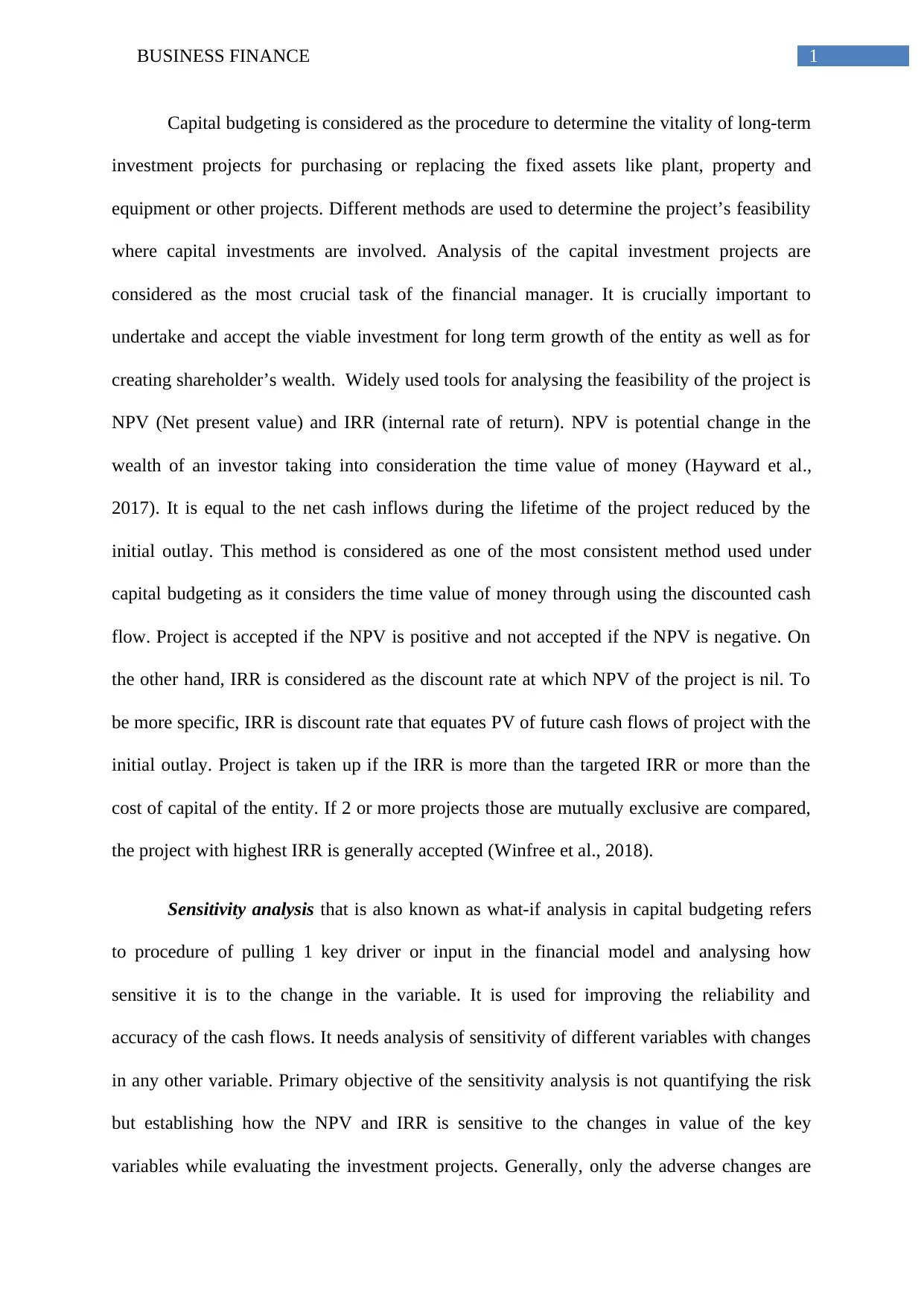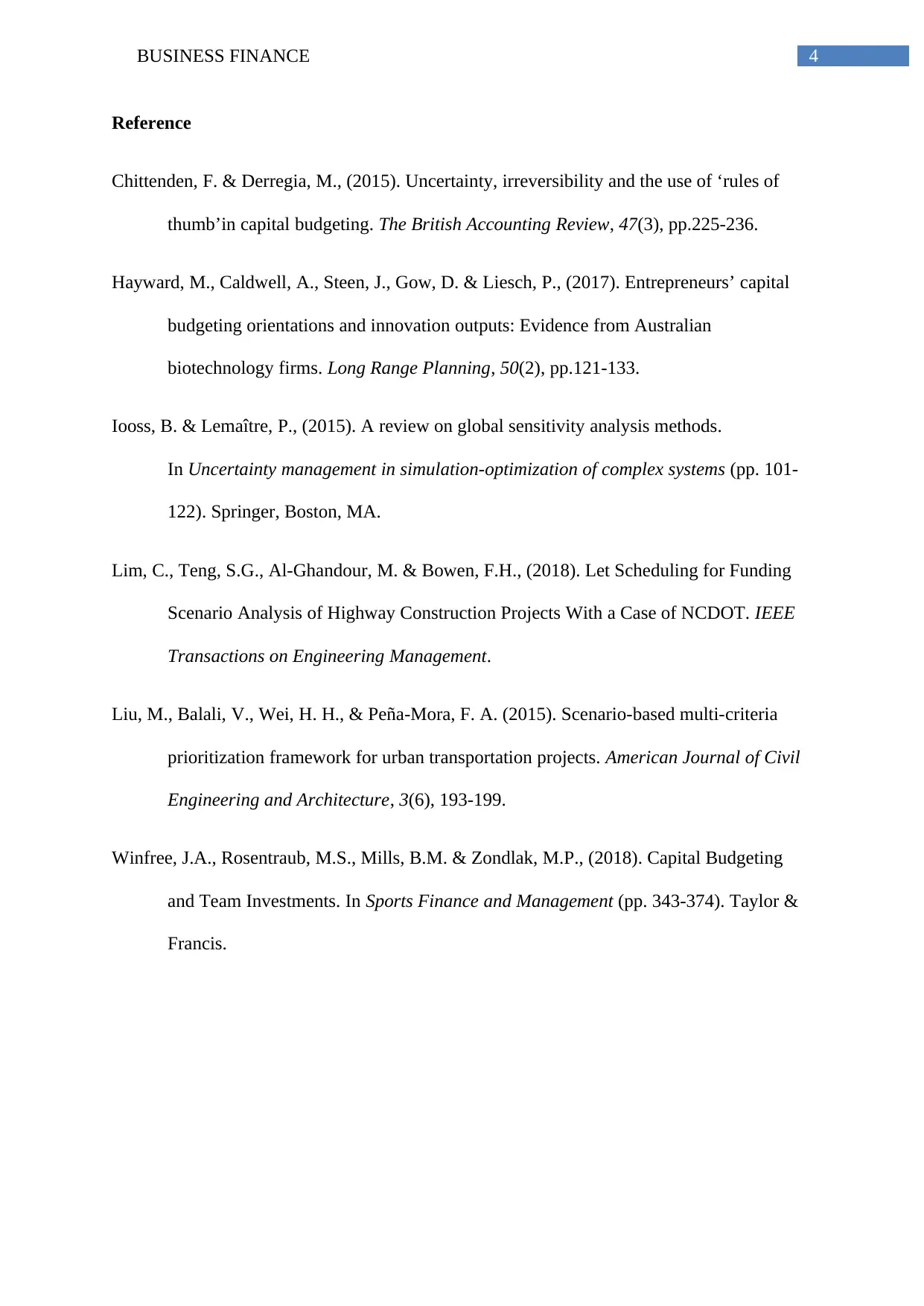Capital Budgeting Techniques and Sensitivity Analysis Report
VerifiedAdded on 2023/04/19
|5
|1191
|369
Report
AI Summary
This report provides an overview of capital budgeting techniques in business finance. It explains the process of determining the viability of long-term investment projects, focusing on the use of Net Present Value (NPV) and Internal Rate of Return (IRR) as primary tools for project evaluation. The report details the significance of sensitivity analysis, also known as what-if analysis, in assessing the impact of changes in key variables on project outcomes. It also covers scenario analysis as a strategic procedure for analyzing decisions by considering various alternative outcomes. The report emphasizes the importance of these analyses in making informed investment decisions and ensuring long-term growth and shareholder wealth. The report also includes relevant references to support the concepts discussed.

Running head: BUSINESS FINANCE
Business finance
Name of the student
Name of the university
Student ID
Author note
Business finance
Name of the student
Name of the university
Student ID
Author note
Paraphrase This Document
Need a fresh take? Get an instant paraphrase of this document with our AI Paraphraser

1BUSINESS FINANCE
Capital budgeting is considered as the procedure to determine the vitality of long-term
investment projects for purchasing or replacing the fixed assets like plant, property and
equipment or other projects. Different methods are used to determine the project’s feasibility
where capital investments are involved. Analysis of the capital investment projects are
considered as the most crucial task of the financial manager. It is crucially important to
undertake and accept the viable investment for long term growth of the entity as well as for
creating shareholder’s wealth. Widely used tools for analysing the feasibility of the project is
NPV (Net present value) and IRR (internal rate of return). NPV is potential change in the
wealth of an investor taking into consideration the time value of money (Hayward et al.,
2017). It is equal to the net cash inflows during the lifetime of the project reduced by the
initial outlay. This method is considered as one of the most consistent method used under
capital budgeting as it considers the time value of money through using the discounted cash
flow. Project is accepted if the NPV is positive and not accepted if the NPV is negative. On
the other hand, IRR is considered as the discount rate at which NPV of the project is nil. To
be more specific, IRR is discount rate that equates PV of future cash flows of project with the
initial outlay. Project is taken up if the IRR is more than the targeted IRR or more than the
cost of capital of the entity. If 2 or more projects those are mutually exclusive are compared,
the project with highest IRR is generally accepted (Winfree et al., 2018).
Sensitivity analysis that is also known as what-if analysis in capital budgeting refers
to procedure of pulling 1 key driver or input in the financial model and analysing how
sensitive it is to the change in the variable. It is used for improving the reliability and
accuracy of the cash flows. It needs analysis of sensitivity of different variables with changes
in any other variable. Primary objective of the sensitivity analysis is not quantifying the risk
but establishing how the NPV and IRR is sensitive to the changes in value of the key
variables while evaluating the investment projects. Generally, only the adverse changes are
Capital budgeting is considered as the procedure to determine the vitality of long-term
investment projects for purchasing or replacing the fixed assets like plant, property and
equipment or other projects. Different methods are used to determine the project’s feasibility
where capital investments are involved. Analysis of the capital investment projects are
considered as the most crucial task of the financial manager. It is crucially important to
undertake and accept the viable investment for long term growth of the entity as well as for
creating shareholder’s wealth. Widely used tools for analysing the feasibility of the project is
NPV (Net present value) and IRR (internal rate of return). NPV is potential change in the
wealth of an investor taking into consideration the time value of money (Hayward et al.,
2017). It is equal to the net cash inflows during the lifetime of the project reduced by the
initial outlay. This method is considered as one of the most consistent method used under
capital budgeting as it considers the time value of money through using the discounted cash
flow. Project is accepted if the NPV is positive and not accepted if the NPV is negative. On
the other hand, IRR is considered as the discount rate at which NPV of the project is nil. To
be more specific, IRR is discount rate that equates PV of future cash flows of project with the
initial outlay. Project is taken up if the IRR is more than the targeted IRR or more than the
cost of capital of the entity. If 2 or more projects those are mutually exclusive are compared,
the project with highest IRR is generally accepted (Winfree et al., 2018).
Sensitivity analysis that is also known as what-if analysis in capital budgeting refers
to procedure of pulling 1 key driver or input in the financial model and analysing how
sensitive it is to the change in the variable. It is used for improving the reliability and
accuracy of the cash flows. It needs analysis of sensitivity of different variables with changes
in any other variable. Primary objective of the sensitivity analysis is not quantifying the risk
but establishing how the NPV and IRR is sensitive to the changes in value of the key
variables while evaluating the investment projects. Generally, only the adverse changes are

2BUSINESS FINANCE
considered under the sensitivity analysis (Iooss & Lemaître, 2015). Main purpose of the
analysis are – (i) helping to recognize key variables that influences benefit streams and
project costs (ii) investigating the outcomes for likely unfavourable changes in the key
variables (iii) assessing whether the project decisions expected to be impacted by these
changes (iv) identifying the action that may mitigate the likely adverse impact on project.
Sensitivity analysis required to be realized in the systematic manner. For meeting the above
mentioned purposes recommended steps required to be followed are – (i) identifying the key
variables to which the decision of the project may become sensitive (ii) computing the impact
of expected changes in the variables on base case NPV or IRR and computing the sensitivity
indicator or / and switching value (iii) considering likely combination of the variables those
are like to be changed simultaneously in adverse action (iv) analysing scale and direction of
expected changes for identified key variables including identification of sources for the
changes (Chittenden & Derregia, 2015).
Scenario analysis is the strategic procedure for analysing the decisions through
considering the possible alternative outcomes. It involves listing of entire series of the inputs
and changing value of each of the input for each of the scenario. It is designed to determine
consequences of the action under various set of the factors. For instance, it represents how the
NPV of investment will vary under low and high inflation. Scenarios shall be feasible enough
to deliver exact picture of outcomes. The good scenario for the investor shall not include
winning lottery as though it is good, it is not probable or realistic to analyse the results (Lim
et al., 2018). Often the scenario analysis uses 3 scenarios – base case, best case and worst
case. Base is the expected scenario – if all the things normally proceed the outcome will be
like this. The best and worst case cases are obviously the scenarios with more and less
favourable conditions, but are restricted by the sense of feasibility. For instance, the investor
generating worst case scenario will not be served well to include the meteor strike that may
considered under the sensitivity analysis (Iooss & Lemaître, 2015). Main purpose of the
analysis are – (i) helping to recognize key variables that influences benefit streams and
project costs (ii) investigating the outcomes for likely unfavourable changes in the key
variables (iii) assessing whether the project decisions expected to be impacted by these
changes (iv) identifying the action that may mitigate the likely adverse impact on project.
Sensitivity analysis required to be realized in the systematic manner. For meeting the above
mentioned purposes recommended steps required to be followed are – (i) identifying the key
variables to which the decision of the project may become sensitive (ii) computing the impact
of expected changes in the variables on base case NPV or IRR and computing the sensitivity
indicator or / and switching value (iii) considering likely combination of the variables those
are like to be changed simultaneously in adverse action (iv) analysing scale and direction of
expected changes for identified key variables including identification of sources for the
changes (Chittenden & Derregia, 2015).
Scenario analysis is the strategic procedure for analysing the decisions through
considering the possible alternative outcomes. It involves listing of entire series of the inputs
and changing value of each of the input for each of the scenario. It is designed to determine
consequences of the action under various set of the factors. For instance, it represents how the
NPV of investment will vary under low and high inflation. Scenarios shall be feasible enough
to deliver exact picture of outcomes. The good scenario for the investor shall not include
winning lottery as though it is good, it is not probable or realistic to analyse the results (Lim
et al., 2018). Often the scenario analysis uses 3 scenarios – base case, best case and worst
case. Base is the expected scenario – if all the things normally proceed the outcome will be
like this. The best and worst case cases are obviously the scenarios with more and less
favourable conditions, but are restricted by the sense of feasibility. For instance, the investor
generating worst case scenario will not be served well to include the meteor strike that may
⊘ This is a preview!⊘
Do you want full access?
Subscribe today to unlock all pages.

Trusted by 1+ million students worldwide

3BUSINESS FINANCE
destroy the entity. On the other hand, under the clearly bad scenario, it is not enough realistic
to be useful. However the conditions and number of scenarios in each of the analysis can
differ. The main aim of scenario analysis is not identifying exact condition for each scenario
rather it requires to approximate them for providing possible idea regarding what may happen
(Liu et al., 2015).
destroy the entity. On the other hand, under the clearly bad scenario, it is not enough realistic
to be useful. However the conditions and number of scenarios in each of the analysis can
differ. The main aim of scenario analysis is not identifying exact condition for each scenario
rather it requires to approximate them for providing possible idea regarding what may happen
(Liu et al., 2015).
Paraphrase This Document
Need a fresh take? Get an instant paraphrase of this document with our AI Paraphraser

4BUSINESS FINANCE
Reference
Chittenden, F. & Derregia, M., (2015). Uncertainty, irreversibility and the use of ‘rules of
thumb’in capital budgeting. The British Accounting Review, 47(3), pp.225-236.
Hayward, M., Caldwell, A., Steen, J., Gow, D. & Liesch, P., (2017). Entrepreneurs’ capital
budgeting orientations and innovation outputs: Evidence from Australian
biotechnology firms. Long Range Planning, 50(2), pp.121-133.
Iooss, B. & Lemaître, P., (2015). A review on global sensitivity analysis methods.
In Uncertainty management in simulation-optimization of complex systems (pp. 101-
122). Springer, Boston, MA.
Lim, C., Teng, S.G., Al-Ghandour, M. & Bowen, F.H., (2018). Let Scheduling for Funding
Scenario Analysis of Highway Construction Projects With a Case of NCDOT. IEEE
Transactions on Engineering Management.
Liu, M., Balali, V., Wei, H. H., & Peña-Mora, F. A. (2015). Scenario-based multi-criteria
prioritization framework for urban transportation projects. American Journal of Civil
Engineering and Architecture, 3(6), 193-199.
Winfree, J.A., Rosentraub, M.S., Mills, B.M. & Zondlak, M.P., (2018). Capital Budgeting
and Team Investments. In Sports Finance and Management (pp. 343-374). Taylor &
Francis.
Reference
Chittenden, F. & Derregia, M., (2015). Uncertainty, irreversibility and the use of ‘rules of
thumb’in capital budgeting. The British Accounting Review, 47(3), pp.225-236.
Hayward, M., Caldwell, A., Steen, J., Gow, D. & Liesch, P., (2017). Entrepreneurs’ capital
budgeting orientations and innovation outputs: Evidence from Australian
biotechnology firms. Long Range Planning, 50(2), pp.121-133.
Iooss, B. & Lemaître, P., (2015). A review on global sensitivity analysis methods.
In Uncertainty management in simulation-optimization of complex systems (pp. 101-
122). Springer, Boston, MA.
Lim, C., Teng, S.G., Al-Ghandour, M. & Bowen, F.H., (2018). Let Scheduling for Funding
Scenario Analysis of Highway Construction Projects With a Case of NCDOT. IEEE
Transactions on Engineering Management.
Liu, M., Balali, V., Wei, H. H., & Peña-Mora, F. A. (2015). Scenario-based multi-criteria
prioritization framework for urban transportation projects. American Journal of Civil
Engineering and Architecture, 3(6), 193-199.
Winfree, J.A., Rosentraub, M.S., Mills, B.M. & Zondlak, M.P., (2018). Capital Budgeting
and Team Investments. In Sports Finance and Management (pp. 343-374). Taylor &
Francis.
1 out of 5
Related Documents
Your All-in-One AI-Powered Toolkit for Academic Success.
+13062052269
info@desklib.com
Available 24*7 on WhatsApp / Email
![[object Object]](/_next/static/media/star-bottom.7253800d.svg)
Unlock your academic potential
Copyright © 2020–2025 A2Z Services. All Rights Reserved. Developed and managed by ZUCOL.




